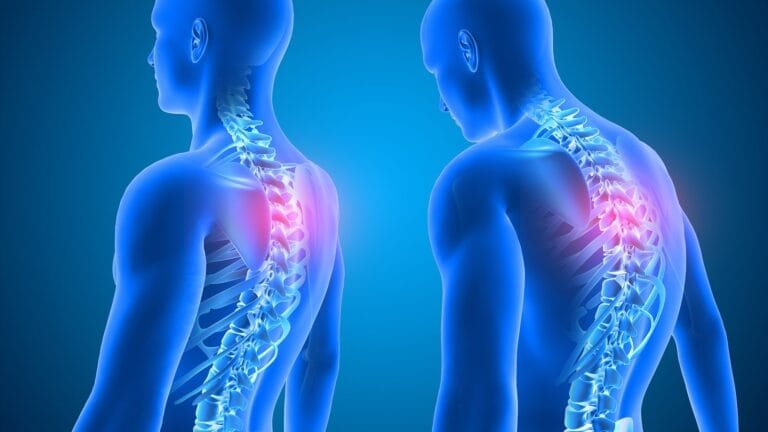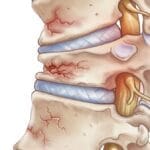Kyphosis is a spinal disorder characterized by an excessive curvature of the spine, resulting in an abnormal rounding of the upper back. This condition, also known as roundback or, in severe cases, hunchback, can affect individuals of any age but is most common during adolescence.
Causes and Symptoms of Kyphosis
In most cases, kyphosis does not cause significant problems and does not require treatment. However, some patients may need to wear a back brace or perform exercises to improve posture and strengthen the spine. Severe cases can be painful, cause significant spinal deformity, and lead to breathing problems, potentially necessitating surgery to reduce the curvature and alleviate symptoms.
Anatomy of the Spine
The spine consists of three segments that form natural curves when viewed from the side:
- Cervical Spine (Neck): C-shaped curve called lordosis
- Thoracic Spine (Chest): Reverse C-shaped curve called kyphosis
- Lumbar Spine (Lower Back): C-shaped curve called lordosis
These natural curvatures are crucial for balance and maintaining an upright posture. The spine’s smaller components include:
- Vertebrae: 24 small, rectangular-shaped bones stacked on top of one another, creating the spine’s natural curves and forming a canal to protect the spinal cord.
- Intervertebral Disks: Flexible, flat, round disks about a half-inch thick that cushion the vertebrae and act as shock absorbers.
Types of Kyphosis
Kyphosis varies in severity and can result from different causes, including postural issues, structural abnormalities, or congenital factors. The three most common types affecting children and adolescents are:
Postural Kyphosis
This most common type usually becomes noticeable during adolescence. It is often identified as poor posture or slouching and is not associated with severe structural abnormalities. The curve is typically round and smooth and can often be corrected by standing up straight. Postural kyphosis is more common in girls, rarely painful, and does not usually progress into adulthood.
Scheuermann’s Kyphosis
Named after the Danish radiologist who first described it, this type often becomes apparent during the teenage years and results in a more severe deformity than postural kyphosis. It is caused by a structural abnormality where three or more consecutive vertebrae become wedge-shaped, creating an exaggerated forward curvature. This type is more common in boys and can be painful, especially during physical activity or long periods of standing or sitting.
Congenital Kyphosis
Present at birth, this type occurs when the spinal column fails to develop normally in the womb, resulting in malformed or fused vertebrae. Congenital kyphosis typically worsens with age and often requires early surgical intervention to prevent progression. These patients may also have other birth defects affecting the heart and kidneys.
Symptoms of Kyphosis
The signs and symptoms vary depending on the cause and severity of the curve:
- Rounded shoulders
- Visible hump on the back
- Mild back pain
- Fatigue
- Spine stiffness
- Tight hamstrings
In rare, severe cases, symptoms may include:
- Weakness, numbness, or tingling in the legs
- Loss of sensation
- Changes in bowel or bladder habits
- Breathing difficulties
Diagnosis and Examination
Mild kyphosis often goes unnoticed until a school scoliosis screening prompts a doctor’s visit. During a physical examination, the doctor will take a medical history and examine the back, looking for tenderness and using the Adam’s forward bend test to observe spinal deformity. X-rays are commonly ordered to determine vertebral changes and measure the degree of the kyphotic curve. Pulmonary function tests may be required for severe cases to assess breathing restrictions.
Treatment Options
The primary goal of treatment is to stop the progression of the curve and prevent deformity. Treatment options depend on the type of kyphosis, the severity of the curve, and the patient’s age and overall health.
Nonsurgical Treatment
- Observation: Monitoring the curve with periodic visits and X-rays until growth is complete.
- Physical Therapy: Exercises to relieve pain, improve posture, and strengthen abdominal and back muscles.
- NSAIDs: Medications such as aspirin, ibuprofen, and naproxen to relieve back pain.
- Bracing: For growing patients with Scheuermann’s kyphosis, wearing a brace to correct the curve.
Surgical Treatment
Surgery is often recommended for patients with congenital kyphosis, severe Scheuermann’s kyphosis (curves greater than 70 to 75 degrees), or significant pain. The most common procedure is spinal fusion, which involves fusing the affected vertebrae to reduce the curve and prevent further progression. Metal screws and rods help align the vertebrae, and bone grafts facilitate the fusion process.
Long-Term Outcomes
Early diagnosis and treatment can help patients lead active, healthy lives. Regular monitoring is essential to check for curve progression, regardless of whether the treatment involves surgery.
Yoast SEO
- Focus Keyphrase: Kyphosis
- Meta Description: Learn about kyphosis, its causes, symptoms, and treatment options. Discover how to manage roundback effectively and improve spine health.
- Synonyms of Keywords:Roundback, hunchback, spinal curvature, thoracic kyphosis
- Keyphrase: Kyphosis





